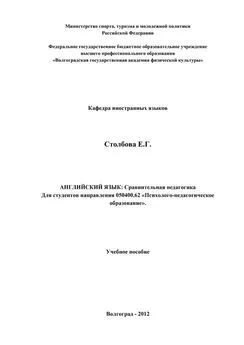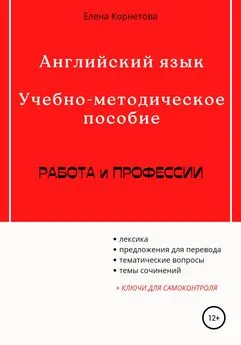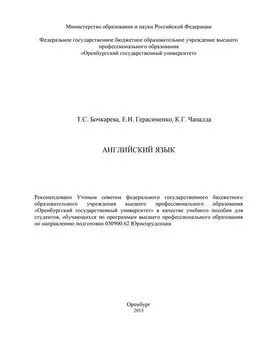Елена Беликова - Английский язык
- Название:Английский язык
- Автор:
- Жанр:
- Издательство:неизвестно
- Год:неизвестен
- ISBN:нет данных
- Рейтинг:
- Избранное:Добавить в избранное
-
Отзывы:
-
Ваша оценка:
Елена Беликова - Английский язык краткое содержание
Студенту без шпаргалки никуда! Удобное и красивое оформление, ответы на все экзаменационные вопросы ведущих вузов России.
Английский язык - читать онлайн бесплатно полную версию (весь текст целиком)
Интервал:
Закладка:
The small intestine is the region within which the process of digestion is completed and its products are absorbed. Although its epithelial lining forms many small glands, they mainly produce mucus. Most of the enzymes present are secreted by the pancreas, whose duct, opens into the duodenum. Bile from the liver also enters the duodenum.
The absorption of the product's of digestion also takes place in the small intestine, although water, salts, and glucose are ab sorbed from the stomach and the large intestine.
The large intestine is chiefly concerned with the preparation, storage and evacuation of undigestible and unabsorbable food residue.
process of digestion – процесс переваривания
сhewing – жевание
saliva – слюна
to moisten – увлажнять
enzyme – фермент
carbohydrates – углеводы
stomach – живот
tongue – язык
hydrochloric acid – соляная кислота
absorption – поглощение
45. The digestive system: the function
The digestive system, or gastrointestinal tract, begins with the mouth, where food enters the body, and ends with the anus, where solid waste material leaves the body. The primary function of the organs of the digestive system are threefold.
First, complex food material which is taken into the mouth must be digested mechanically and chemically, as it travels through, the gastrointestinal tract.
Second, the digested food must be absorbed by passage through the walls of the small intestine into the blood stream so that the valuable energy-carrying nutrients can travel to all cells of the body.
The third function of the gastrointestinal tract is to eliminate the solid waste materials which are unable to be absorbed by the small intestine.
In the man the food in the mouth is masticated, that is to say it is bitten and broken up by the teeth and rolled into the bolus by the tongue.
The act of swallowing is divided into three stages
The first stage is under voluntary control. The food which has been transformed into a soft, mass by the act of mastication is brought into position upon the root of the tongue, and by the action of the lingual muscles is rolled backwards towards the base of the tongue.
The second stage is brief and is occupied in guiding the food through the pharynx and past the openings that lead from it. The muscular movements during this stage are purely reflex in nature. The third stage involves the passage of the food down the eso phagus. The food is seized by peristaltic wave which, traveling along the esophagus, carries the material before it into the stomach. The cardiac sphincter which guards the lower end of the esophagus and which at other times is kept tonically closed re laxes upon the approach of the bolus which is then swept into the stomach by the wave of constriction which follows.
Peristalsis is a type of muscular contraction characteristic of the gut and consists in waves of contraction, these running along the muscles, both circular and longitudinal, towards the anus.
If the food is fluid it enters the stomach six seconds after the beginning of the act, but If It is solid it takes much long e r, up to fifteen minutes, to pass down the esophagus.
In the stomach the food is thoroughly mixed by the series of contractions, three or four a minute, the contraction waves passing from the middle of the stomach to the pylorus. These tend to drive the food in the same direction, but the pylorus being closed, there is axial reflex, owing to which the food is well mixed. After a time – a bout a minute when water has been swallowed – the pylorus relaxes at each wave, allowing some of the stomach contents to enter the duodenum. Fat stays in the stomach longer than carbo hydrate, but all food leaves generally in three or four hours. In the small intestine the food continues to be moved by peristalsis, the latter controlled by the deep nerve plexus. The small intestine undergoes segmentation movements, the food contents being thoroughly mired The wall becomes constricted into a number of segments and then about five seconds later the constrictions disappear, there being another set exactly out of phase with the first. The large intestine undergoes infrequent powerful contractions, food having entered it. From the large intestine the food enters the rectum.
voluntary control – добровольный контроль
soft – мягкий
mastication – перетирание
position – положение
root – корень
46. The digestive system: liver and stomach. Sources of energy
Liver, the pancreas and the kidneys are the organs primarily engaged in the intermediary metabolism of the materials resorbed from the gasro – intestinal tract and in the excretion of metabolic waste products Of these 3 organs the liver performs the most diverse functions. It acts as the receiving depot and distributing center for the majority of the products of intestinal digestion and plays a major role in the intermediary metabolism of carbohydrates, fats, proteins and purines.
It controls the concentration of cholesterol esters in the blood and utilizes the sterol in the formation of bile acid. The liver takes in the regulation of the blood volume and in water metabolism and distribution. Its secretion, the bile, is necessary for fat digestion
The liver is a site for the formation of the proteins of the blood plasma, especially for fibrinogen, and also forms heparin, also forms heparin, carbohydrate which prevents the clotting of the blood It has important detoxicating functions and guards the organism against toxins of in testinal origin as well as other harmful substances The liver in its detoxicating functions and manifold metabolic activities may well be соnsidered the most important gland of the body.
The normal position of the empty human stomach is not horizontal, as used to be thought before the development of rentgenology. This method of examination has revealed the stomach to be either somewhat J-shaped of comparable in outline to a reversed L. The majority of normal stomachs are J-shaped. In the J-shaped type the pylorus lies at a higher level than the lowest part of the greater curvature and the body of the stomach is nearly vertical.
The stomach docs not empty itself by gravity, but through the contraction of its muscular wall like any other part of the diges tive tube, of which it is merely a segment.
Gastric motility shows great individual variation; in some types of stomach the wave travels very rapidly, completing its journey in from 10 to 15 seconds. In others the wave takes 30 seconds or go to pass from its origin to the pylorus. The slow waves are the more common.
The fuels of the body are carbohydrates, fats and proteins. These are taken in the diet.
Carbohydrates are the principal source of energy in most diets. They are absorbed into the blood stream in the form of glucose. Glucose not needed for immediate use is converted into glycogen and stored in the liver. When the blood sugar concentration goes down, the liver reconverts some of its stored glycogen into glucose.
Pats make up the second largest source of energy in most diets. They are stored in adipose tissue and round the principal internal organs. If excess carbohydrate is taken in, this can be converted into fat and stored. The stored fat is utilized when the liver is empty of glycogen.
Proteins are essential for the growth and rebuilding of tissue, but they can also be utilized as a source of energy. In some diets, such as the diet of the Eskimo, they form the main source of energy. Proteins are first broken down into amino acids. Then they are absorbed into the blood and pass round the body. Amino acids not used by the body are eventually excreted in the urine in the form of urea. Proteins, unlike-car-bohydrates and fats, cannot be stored for future use.
fuels – топливо
principal source – основной источник
energy – энергия
glucose – глюкоза
glycogen – гликоген
stored – сохраненный
adipose – животный жир
amino acids – аминокислоты
47. The urinary system: embriogenesis
The urinary system is formed mainly from mesodermal and endodermal derivatives. Three separate systems form sequentially. The pronephros is vestigial; the mesonephros may function transiently, but then mainly disappears; the metanephros develops into the definitive kidney. The permanent excre tory ducts are derived from the metanephric ducts, the urogenital sinus, and surface ectoderm.
Pronephros: Segmented nephrotomes appear in the cervical intermediate mesoderm of the embryo in the fourth week. These structures grow laterally and canalize to form nephric tubules. Successive tubules grow caudally and unite to form the pronephric duct, which empties into the cloaca. The first tubules formed regress before the last ones are formed.
Mesonephros: In the fifth week, the mesonephros appears as «S-shaped» tubules in the intermediate mesoderm of the thoracic and lumbar regions of the embryo.
The medial end of each tubule enlarges to form a Bowman's capsule into which a tuft of capillaries, or glomerulus, invaginates.
The lateral end of each tubule opens into the meson-ephriс (Wolffian) duct.
Mesonephric tubules function temporarily and degenerate by the beginning of the third month. The mesonephric duct pesists in the male as the ductus epididymidis, ductus deferens, and the ejaculatory duct.
Metanephros: During the fifth week, the metanephros, or permanent kidney, develops from two sources: the ureteric bud, a diverticulum of the mesonephric duct, and the metan-ephricmas, from intermediate mesoderrn of the lumbar and sacral regions. The ureteric bud penetrates the metanephric mass, which cordenses around the diverticulum to form the metanephrogen cap. The bud dilates to form the renal pelvis. One-to-three million collecting tubules develop from the minor calyces, thus forming the renal pyramids. Penetration of collecting tubules into the metanephric mass induces cells of the tissue cap to form nephrons, or excretory units. The proximal nephron forms Bowman's capsule, wherea the distal nephron connects to a collecting tubule.
Lengtheningy of the excretory tubule gives rise to the proximal convoluted tubule, loop of Henle, and the distal convoluted tubule.
The kidneys develop in the pelvis but appear to «as-cend» into the abdomen as a result of fetal growth of the lumbar and sacral regions.
The upper and largest part of the urogenital sinus becomes the urinary bladder, which is initially continuous with the allantois. Later the lumen of the allantois becomes obliterated. The mucosa of the trigone of the bladder is formed by the incorporation of the caudal mesonephric ducts into the dorsal bladder wall. This mesodermal tissue is eventually replaced by endodermal epithelium so that the entire lining of the bladder is of endodermal origin. The smooth muscle of the bladder is derived from splanchnic mesoderm.
Mile urethra is anatomically divided into three portions: prostatic membranous, and spongy (penile).
The prostatic urethra, membranous urethra, and proximal penile urethra develop from the narrow portion of the urogenital sinus below the urinary bladder. The distal spongy urethra is derived from the ectodermal cells of the glans penis.
Читать дальшеИнтервал:
Закладка:










